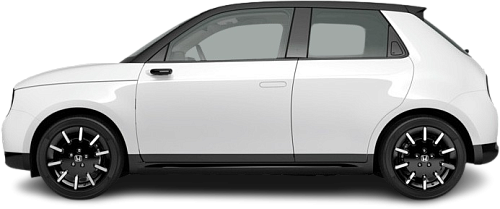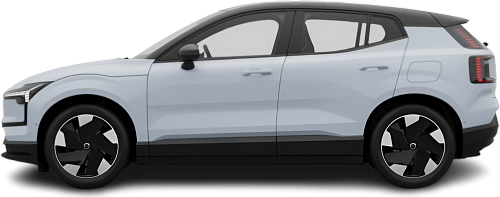USA EV Comparison: Honda e Advance vs Volvo EX30 Single Motor
Struggling to Decide? Let AI Help!
Your AI Summary Is Ready!
General Info
While the Volvo EX30 Single Motor (2023-…) is currently produced, it is not offered for sale in the United States. The Honda e Advance (2020-2023) has been discontinued, it was never offered for sale in the United States.
The Honda e Advance (2020-2023) is a Hatchback, whereas the Volvo EX30 Single Motor (2023-…) is a SUV.
| Property | Honda e Advance | Volvo EX30 Single Motor |
|---|---|---|
| Years of Production | 2020-2023 | 2023-… |
| Current Status | Discontinued | Produced |
| Country of Manufacture | Japan | China |
| Body Style | Hatchback | SUV |
| Market Availability | EU | EU |
| GCC Score | 4.7 | 6.1 |
Range and Efficiency
While the Volvo EX30 Single Motor (2023-…) offers a longer real-world range and a bigger battery, it is less energy-efficient than the Honda e Advance (2020-2023).
| Property | Honda e Advance | Volvo EX30 Single Motor |
|---|---|---|
| Range (WLTP) | 138 mi | 214 mi |
| Range (GCC) | 117 mi | 181 mi |
| Battery Capacity (Nominal) | 35.5 kWh | 51 kWh |
| Battery Capacity (Usable) | 28.5 kWh | 49 kWh |
| Efficiency per 100 mi | 24.4 kWh/100 mi | 27.1 kWh/100 mi |
| Efficiency per kWh | 4.11 mi/kWh | 3.69 mi/kWh |
| Range and Efficiency Score | 5.8 | 5.9 |
Charging
Both vehicles utilize a standard 400-volt architecture.
The Volvo EX30 Single Motor (2023-…) offers faster charging speeds at DC stations, reaching up to 175 kW, while the Honda e Advance (2020-2023) maxes out at 46 kW.
The Volvo EX30 Single Motor (2023-…) features a more powerful on-board charger, supporting a maximum AC charging power of 11 kW, whereas the Honda e Advance (2020-2023) is limited to 6.6 kW.
| Property | Honda e Advance | Volvo EX30 Single Motor |
|---|---|---|
| Max Charging Power (AC) | 6.6 kW | 11 kW |
| Max Charging Power (DC) | 46 kW | 175 kW |
| Architecture | 400 V | 400 V |
| Charge Port | CCS Type 2 | CCS Type 2 |
| Charging Score | 3.6 | 6 |
Performance
Both vehicles are rear-wheel drive.
The Volvo EX30 Single Motor (2023-…) boasts greater motor power and accelerates faster from 0 to 60 mph.
| Property | Honda e Advance | Volvo EX30 Single Motor |
|---|---|---|
| Drive Type | RWD | RWD |
| Motor Type | PMSM | PMSM |
| Motor Power (kW) | 113 kW | 200 kW |
| Motor Power (hp) | 152 hp | 268 hp |
| Motor Torque | 232 lb-ft | 253 lb-ft |
| 0-60 mph | 8 s | 5.5 s |
| Top Speed | 90 mph | 112 mph |
| Performance Score | 3 | 4.3 |
Dimensions
The Volvo EX30 Single Motor (2023-…) is longer, wider, and taller.
The Volvo EX30 Single Motor (2023-…) boasts a more extended wheelbase.
| Property | Honda e Advance | Volvo EX30 Single Motor |
|---|---|---|
| Length | 153.3 in | 166.7 in |
| Width (with Mirrors) | - Width (with Mirrors) | 80 in |
| Width (w/o Mirrors) | 69 in | 72.4 in |
| Height | 59.5 in | 61 in |
| Wheelbase | 99.9 in | 104.3 in |
Cargo and Towing
The Volvo EX30 Single Motor (2023-…) features a larger trunk, but the Honda e Advance (2020-2023) offers greater maximum cargo capacity when the rear seats are folded.
A frunk (front trunk) is available in the Volvo EX30 Single Motor (2023-…), but the Honda e Advance (2020-2023) doesn’t have one.
The Volvo EX30 Single Motor (2023-…) has a towing capacity of up to 2205 lb, whereas the Honda e Advance (2020-2023) is not officially rated for towing in the US.
| Property | Honda e Advance | Volvo EX30 Single Motor |
|---|---|---|
| Number of Seats | 4 | 5 |
| Curb Weight | 3516 lb | 4057 lb |
| Cargo Volume (Trunk) | 6 ft3 | 11.2 ft3 |
| Cargo Volume (Max) | 30.4 ft3 | 29.8 ft3 |
| Cargo Volume (Frunk) | - Cargo Volume (Frunk) | 0.2 ft3 |
| Towing Capacity | - Towing Capacity | 2205 lb |
| Cargo and Towing Score | 3.8 | 5.9 |




